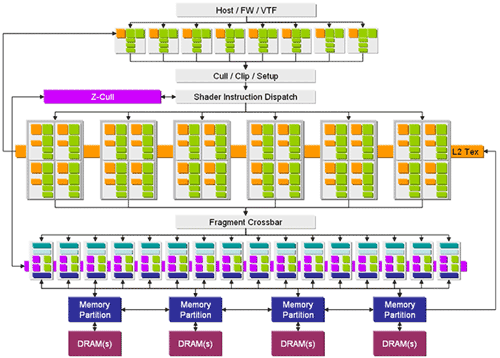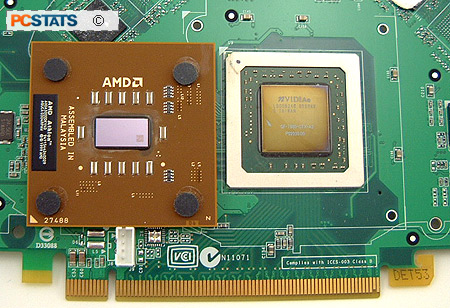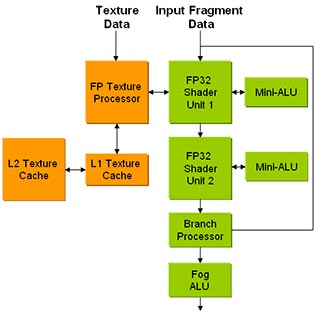The nVidia
Geforce 7800GTX GPU (formerly known as 'G70') is based quite closely
on the nVidia Geforce 6800 Ultra graphics processor. That said, there are several
significant improvements and tweaks which should add up to a large overall
performance boost.

Let's get the nuts and bolts out of the way first. The key
architectural differences between the G70 core and the Geforce 6800Ultra start
with the size and manufacture of the GPU. The G70 is based on TSMC's 110nm
process and incorporates a mind-boggling 302 million transistors. To put this in
perspective, an AMD Athlon 64 FX-55 CPU has only 105.2 million! The G70 core
itself measures 18.5 x 18.5mm in size, quite large considering it's built
on 0.11 micron. Below, you can see the 7800GTX GPU side by side with an AthlonXP
3000+, the videocard processor is almost four times the surface area!

The
reference Geforce 7800 GTX videocard runs at a speed of 430MHz to start
with, and uses 256MB of GDDR3 memory clocked at 1.2GHz. This provides the
reference card with a total bandwidth of 38.4GB/s.
Internally, the 7800
GTX has 8 vertex shader units to the 6800's 6, and a
total of 24 pixel pipelines (six groups of four quad pixel operators) to
the older GPU's 16. The nVidia Geforce 7800 GTX will boast a fill rate of
10.3 Gigatexels, considerably more than the Geforce 6800 Ultra's 6.4
Gigatexels.
The 16 ROPs (Render OPerators) are the same amount
found in the 6800 Ultra, meaning that it can't actually render any more pixel
data to memory than could the NV40. According to nVidia, this wasn't a
bottleneck preventing higher graphics performance.
Smoke and mirrors = eye candy
Up to
this point, everything is as expected. Newer GPU equals more pixels per clock
plus more bandwidth equals faster.  Duh. Hold on there
though... Things might not be quite as they seem. The 7800GTX actually marks a
significant shift in emphasis by the nVidia design team towards effects and
shader tricks as opposed to raw rendering power.
Duh. Hold on there
though... Things might not be quite as they seem. The 7800GTX actually marks a
significant shift in emphasis by the nVidia design team towards effects and
shader tricks as opposed to raw rendering power.
Yes, the
GPU is faster than its predecessors (and apparently its current ATI competitors)
and will get faster still, but the most significant architectural increase is
inside the pixel pipelines.
The 8 additional pixel shader pipeline do massively
increase fill rate, but all the pipelines benefit from a major internal
improvement: enhanced MADD (Multiplication-ADDition) capabilities.
Each
pixel pipeline has two ALUs (Arithmetic Logic Units) which perform adding and
multiplying operations on each pixel to apply various graphical effects. In the
6800 GPU, only one of these ALUs could perform true MADD (both multiplying and
adding) operations which are important to many 3D effects.
With the
7800 GTX, both ALUs are capable of 2 MADD operations each, vastly increasing the
power of the GPU in certain operations which nVidia feels will be necessary for
gaming in the future.
This
improvement to the pixel pipelines does not increase the overall fill rate, but
it does affect what the GPU can do with each pixel on each clock cycle. The
additional MADD operations will allow for much faster rendering of complex
transform and lighting effects and image maps, which sheer fill rate alone
cannot compensate for.
